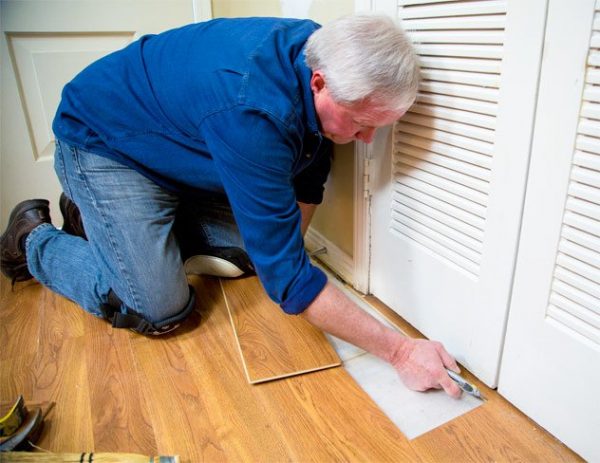 ❏ Check your sump pump. Clean the sump pump and pit, and check the pump by pouring water into the pit. Consider having a spare submersible portable sump pump. Ensure the discharge hose pipe delivers the water several feet away from the house to a well-drained area that slopes away from your house. If the tube outlet is too close to your house structure or on flat ground, the water may simply recycle down through your house drain tile. Don't run sump pump water into a rural septic system due to the fact that the water may fill the drain field. In cities, running sump pump water into the sanitary system may overload the system and trigger sewage backup, plus it might be illegal.
❏ Check your sump pump. Clean the sump pump and pit, and check the pump by pouring water into the pit. Consider having a spare submersible portable sump pump. Ensure the discharge hose pipe delivers the water several feet away from the house to a well-drained area that slopes away from your house. If the tube outlet is too close to your house structure or on flat ground, the water may simply recycle down through your house drain tile. Don't run sump pump water into a rural septic system due to the fact that the water may fill the drain field. In cities, running sump pump water into the sanitary system may overload the system and trigger sewage backup, plus it might be illegal.

 ❏ Move belongings to higher places. Get items such as irreplaceable family picture albums, high school yearbooks, individual videos, tax records, insurance coverage and household stocks off the bottom shelves in the lower level of your house.
❏ Move belongings to higher places. Get items such as irreplaceable family picture albums, high school yearbooks, individual videos, tax records, insurance coverage and household stocks off the bottom shelves in the lower level of your house.
❏ Move dangerous materials to greater areas. This includes paint, oil, cleaning supplies and other hazardous materials.
❏ Move snow far from your house's foundation. If the ground is sloped 1 inch per foot near your house, moving snow simply 3 to 5 feet from the house will reduce issues.
❏ Keep water out of window wells. Since windows can't endure much pressure, construct dams and contour the ground so water will naturally recede from your house.
❏ Get downspouts down in place so that as snow melts they can carry the water away from the house. Using salt or a chemical to melt them free will most likely harm the lawn.
❏ Plan an escape route if specific roadways or streets are known to flood easily. Where would you go if your house flooded - a regional shelter, a relative or pal's house?
❏ Plan for animals. Pets aren't allowed shelters due to health guidelines. If left behind, stressed pets can harm your house, and their safety is at stake too.
❏ Assemble materials in case the electrical energy goes off. Gather water, food that requires no refrigeration or cooking, a non-electric can opener, a battery-powered radio and flashlight, additional batteries.
❏ Assemble materials for a possible evacuation. Gather water, nonperishable food, paper plates/cups and plastic utensils, additional clothes and shoes, blankets or sleeping bags, an emergency treatment set and prescription medications, cash and credit cards, essential telephone number, special items for babies and the elderly.
❏ Anchor fuel tank. A fuel tank can topple or drift in a flood, causing fuel to spill or ignite. Tidying up a home that has actually been swamped with flood waters containing fuel oil can be extremely hard and costly. Fuel tanks need to be safely anchored to the flooring. Make certain vents and fill line openings are above predicted flood levels. If you have lp tanks that are the property of the lp business, you'll need written permission to anchor them, or you can ask whether the company can do it for you.
❏ Plug basement floor drains with detachable grids if drain backup might occur. Install drain plugs readily available from hardware stores. One kind of plug has a rubber center that broadens to fill the pipe when the top and bottom metal plates are squeezed. If an industrial plug is not available, a flexible rubber ball about 1 1/4 times the inside diameter of the pipeline can be wedged into the drain to produce a tight seal. Brace the ball securely in the drain with a 2X4 against the ceiling. Hold a board or piece of plywood on the ceiling and move the 2X4 against the bottom of the board to prevent damage to plaster ceilings. For a suspended tile ceiling, remove ceiling tiles to get access to the ceiling joists. Span a 2X4 throughout the two joists and wedge the vertical 2X4 between it and the ball.
❏ Cover basement floor drains with long-term grids. Place a partially inflated inner tube around the drain, and top it with a square or two of plywood (not particle board). The plywood needs to be bigger across than the inner tube to cover it. Brace this in place just as with the ball on the drain. Be gotten ready for some seepage.
❏ Reduce flooding from other drains pipes. Unbolt toilets from the flooring and plug the outlet pipeline using the very same treatment as for floor drains pipes. Shower drains pipes can be plugged in this manner too. Most cleaning makers and basement sinks have their drain connections about 3 feet above the floor so may not overflow if the water does not get that high. If needed, these drains pipes can be detached and capped or plugged with commercial plugs or braced rubber balls.
❏ Prepare appliances for flooding. Turn off appliances at the circuit box or breaker panel. Put freezers, washer, clothes dryers and other appliances up on wood or cement obstructs to keep the motors above the water level. If high water looms and large devices can't be moved, wrap them in polyethylene film, tying the movie in location with cable or rope. The water will still get in, but the majority of the silt won't so cleanup will be much easier.
❏ Shut off electrical power to locations of the home that may flood. Even if floodwaters are not reaching electric outlets, the danger of electrical shock to someone working in a flooded basement is high with electrical motors in the heater, freezer, washer, dryer and other appliances. Turn off electrical breakers or unscrew fuses. Don't stand in water and switch off electrical switches. If this should be done, use a dry piece of wood or a plastic or rubber pole to do the changing, and stand on a block of wood or a plastic cage that doesn't perform electricity. If floodwaters are getting close to the electrical entrance box, call the power provider and have the electrical supply to the house detached. If the flooring perspires however not truly flooded, ground fault circuit interrupters reduce the threat of using electricity. In newer houses, interrupters can be determined by the buttons between the top and bottom outlets. They can be contributed to any outlet or in an extension cable to switch off the power if an electrical fault takes place.
Family
❏ Discuss what to do in case of a flood. Plan and practice an evacuation path.
❏ Ask an out-of-state family member or friend to be your family contact. If member of the family get separated throughout an evacuation, each should get in touch with that contact. Ensure everybody has the contact's phone numbers.
❏ Discuss safe emergency treatments. Teach adults and older kids where circuit box, water service mains and gas mains are and how to turn them off if essential.
❏ Discuss the scenario with kids truthfully and honestly. Hiding the situation from them will most likely be a lot more stressful.